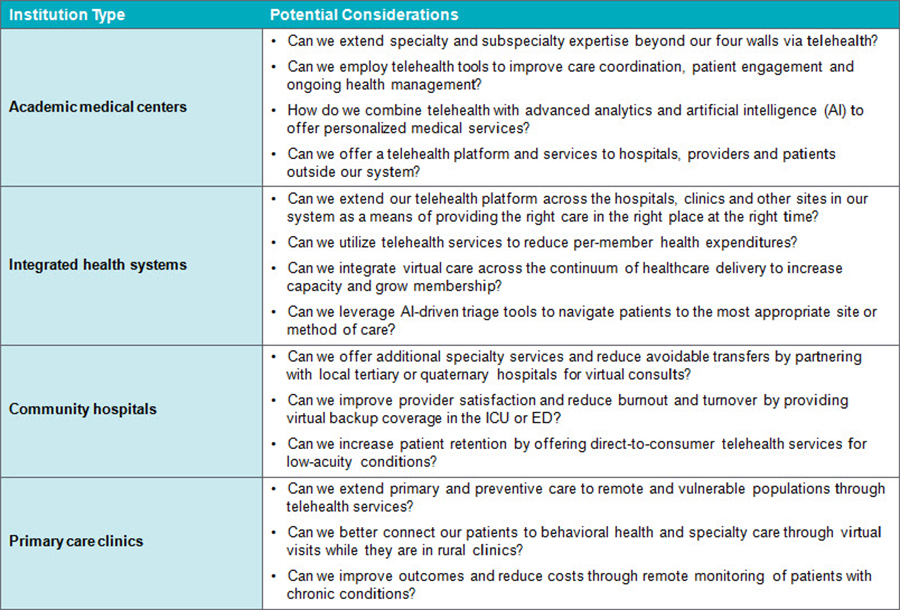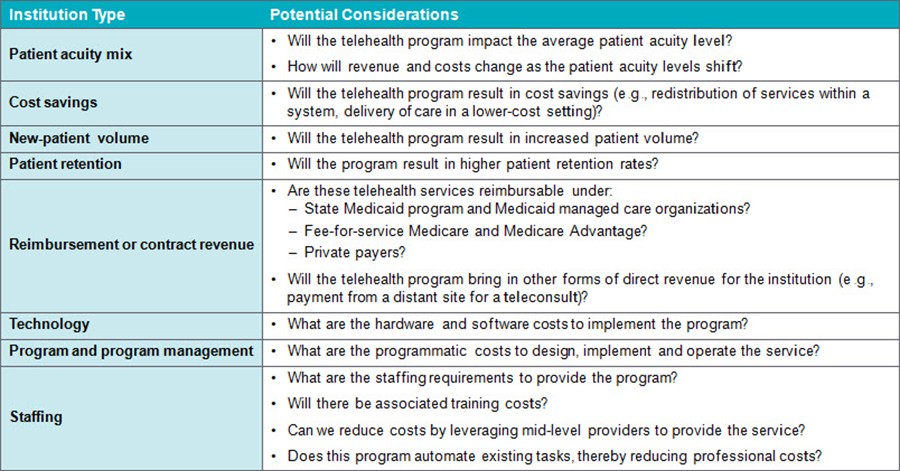Manatt thanks Sol Lee, summer analyst, for his contributions.
Editor’s Note: The return on investment (ROI) of telehealth programs can vary dramatically among organizations. Because different types of providers have different characteristics, their ROI considerations around telehealth investments also are fundamentally different. Since the decision to invest in telehealth is highly dependent on the institution’s objectives, as well as the estimated financial impact of the telehealth program, Manatt Health has developed a new white paper that proposes a framework for calculating the ROI of a particular telehealth program, demonstrates how the framework can be applied through two distinct case studies, and illustrates the financial impact of specific telehealth programs. The article below summarizes key points. Click here to download a free copy of the full white paper.
Healthcare providers are increasingly investing in and deploying telehealth capabilities that will extend services to patients in rural areas; deliver higher-quality care to individuals with complex conditions; and reduce costs associated with unnecessary emergency department visits, transfers and admissions, among other benefits.
Telehealth programs require institutions to make upfront investments in technology, program design and staffing. While payers are increasingly expanding coverage for telehealth services, receiving reimbursement across all payers at a level commensurate with costs continues to be a challenge. To that end, providers are eager to think beyond reimbursement and understand the potential comprehensive return on investment (ROI) of various telehealth programs.
The ROI of telehealth programs can differ significantly based on the size, nature, clinical capacity and payment model of the organization. For instance, academic medical centers (AMCs) typically have a highly specialized workforce that treats high-acuity patients across a wide range of clinical domains. In contrast, many community hospitals are smaller, have a more generalized workforce and may not provide comprehensive services at all hours of the day. Similarly, an integrated healthcare delivery system that operates on a value-based versus a fee-for-service basis may be more interested in the cost-saving potential of telehealth programs. The different characteristics of these institutions make their ROI considerations around various telehealth investments fundamentally different, as summarized in Table 1.
Table 1. ROI Considerations for Different Types of Providers

Principles and Considerations of ROI Modeling for Telehealth
Provider organizations should assess a potential telehealth program’s impact on value by evaluating the program’s impact on improving revenue, health outcomes and patient experience relative to cost. In addition to the direct economic drivers, telehealth programs can generate value in a number of ways that may be difficult to measure. These include increasing access to care, allowing patients to receive care in more convenient settings, and improving patient and provider satisfaction.
To assist organizations in calculating an observable ROI of a potential telehealth program, Manatt’s proposed framework relies on the measurable impacts of a program. It does not account for or place value on the nonfinancial benefits noted above. Accordingly, providers should weigh the resulting ROI along with nonfinancial benefits when determining whether or not to move forward with a telehealth investment.
Table 2 provides financial considerations and general questions for providers that are attempting to estimate the financial impact of a telehealth program.
Table 2. Considerations and Guiding Questions for Evaluating Telehealth ROI

Conclusion
Providers are leveraging telehealth to optimize delivery of care, reach patients in remote locations, and improve care quality and overall patient satisfaction. Healthcare institutions should anticipate that for the time being the most significant financial benefits from telehealth programs are likely to be the result of changes to patient acuity levels and increases in new or retained patient volume, rather than the result of increases in reimbursement.
Note: Click here to access the full paper, including case studies demonstrating how the framework can be applied.